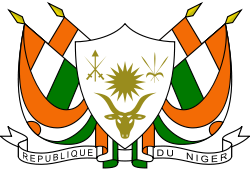Niger National Adaptation Programme of Action (NAPA)
Project Overview
National Adaptation Programmes of Action (NAPAs) provide a process for Least Developed Countries (LDCs) to identify priority activities that respond to their immediate needs to adapt to climate change, ultimately leading to the implementation of projects aimed at reducing the economic and social costs of climate change.
For Niger, the National Adaptation Programme of Action (NAPA) from August 2006 details the Main Human Vulnerabilities and Livelihood Impacts:
- Reduced agricultural production
- Reduced fishery productivity
- Water shortage and/or groundwater depletion
- Increased disease and/or other health problems
- Income generation
- Loss of forest area or production
- Loss of biodiversity
- Loss of land or degradation
Project Details
The climate in Niger is of the Sahelian type characterized by a great interannual rainfall, which has been expressed by multi-year droughts since 1968. This situation, linked to the climate nature and changes, through the adverse effects of extreme weather events, constitutes a great disadvantage for the development of the country. In fact, the ecosystems frailty makes the country very vulnerable to these events and the difficult socio-economic situation weakens its adaptability. In this regards , adaptation measures are necessary, in order to achieve a sustainable development.
The overall objective of the NAPA is to contribute to the alleviation of the adverse effects of climate variability and changes on the most vulnerable populations with the prospect of a sustainable development. In this area, some adaptation measures, consistent with the orientations of the Poverty Reduction Strategy (PRS) contained in the Rural Development Strategy (SDR), were identified. These adaptation measures are all in synergy with the measures of the Post-Rio convention adopted by Niger, especially the United Nations Framework on Climate Changes (UNFCCC), Convention to Combat Desertification (CCD), and the Convention on Biodiversity (CBD).
Niger is a sahelian landlocked country whose nearest point to the sea is about 600 km. It covers a surface area of 1,267,000 sq km. It is located between the longitude 0°16’ and 16° East and the latitude 11°1’ and 23°17’ North. The three fourths of the country’s land area are occupied by deserts among which the Ténéré, one of the most wonderful deserts in the world.
The country’s economy is based mainly on agriculture and cattle breeding . Furthermore, soils are generally poor and the area potentially suitable for crop production, estimated at 15 millions hectares, represent 12% of the country’s total surface area. These lands, mainly covered by dunes, measure low in productivity and are sensitive to erosion due to water and wind. Niger's population was estimated at 11,060,291 people in 2001 (General census, 2001). Mainly rural, the populations draw most of their incomes from natural resources exploitation.
The growth rate of the population is one of the highest in the world. It was about 3.3 % in 2001. This population growth combined with difficult climatic conditions (droughts) and inadequate and not very rational use of natural resources led to ecological imbalances expressed by the deterioration of livelihoods. According to the trends from national statistics, the population will reach 17.3 millions by 2015 and 24.1 millions by 2025
Climate Related Hazards
- Flooding (flash)
- Drought and low flows
- Windstorms
- Sand/dust storms
- Extreme temperatures
- Forest fires
Main Human Vulnerabilities and Livelihood Impacts
- Reduced agricultural production
- Reduced fishery productivity
- Water shortage and/or groundwater depletion
- Increased disease and/or other health problems
- Income generation
- Loss of forest area or production
- Loss of biodiversity
- Loss of land or degradation
Key Results and Outputs
The NAPA process started in 2005. Its implementation was carried out within strict respect of the different steps indicated by the LEG guidelines and by focusing on three approaches:
- A consultative and participatory approach involving all the parties, particularly the regions, local authorities, local communities, representatives of the private sector, NGOs and Civil Social organizations....
- A multi-disciplinary and transparent approach based on the participation of all the specialists (as indicated in the list of the NAPA experts) on climate variability and changes
- A complementary approach in which synergy with the existing National Plans and Programmes and Multilateral Environmental Agreements is taken into account
This process got the following results:
- Identification of sectors, communities and areas that are most vulnerable to climate
- variability and changes;
- Identification of adaptation measures and sectors priority needs, communities and
- areas that are vulnerable to climate variability and changes;
- Identification of fourteen adaptation options listed below:
- Fodder crops species introduction in pastoral areas
- Promotion of food banks for livestock
- Restoration of basins for the promotion of crop irrigation
- Diversification and intensification of crop irrigation
- Promotion of peri-urban market gardening and cattle breeding
- Promotion of income-making activities and development of mutual benefit societies
- Mobilization of surface water and exploitation of ground water
- Production and dissemination of agro-meteorogical data
- Promotion of food banks
- Contribution to the fight against climate sensitive diseases
- Development of anti-erosion infrastructures (CES/DRS) for agricultural forestry and pastoral purposes
- Popularization of animal and vegetative species that are most adapted to climatic conditions
- Protection of riversides and restoration of silted up ponds
- Building material, technical and organizational capacities of rural producers




